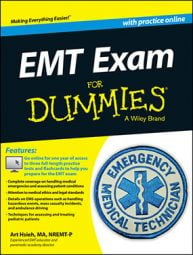The EMT exam will expect you to know how to handle a normal delivery. Although the majority of newborn deliveries occur within the confines of a labor and delivery suite, there’s a chance that you’ll be called upon to perform a delivery as an EMT.
While that may instill panic in your heart, rest assured that delivery is a normal process and that the vast majority of deliveries are not complicated. Your knowledge, technique, and confidence will go a long way in reassuring the mother-to-be and making the delivery successful.
Here are key steps to keep in mind when performing a normal delivery:
There may be a gush of fluid as the amniotic sac breaks and labor begins, as well as a bloody show — the mucous plug covering the cervix drops away during a contraction.
The mother experiences intermittent contractions that become longer and more regular.
Contractions are timed from the start of one to the start of the next. These contractions are widening, or dilating, the cervix to allow delivery to occur.
Contractions become very strong as delivery begins; the cervix is now fully dilated.
If the mother feels the need to move her bowels, delivery is imminent. Prepare your OB kit and find a quiet, private space to perform the delivery.
The baby’s head emerges first, face down.
Within a few seconds, the head turns sideways as the shoulders twist their way past the pubic bone.
As soon as the head appears, consider using a bulb syringe to clear the nose and then the mouth of the newborn. Squeeze the bulb first, and then insert the tip into the nares or mouth and release. Repeat until clear.
The head drops down slightly as the next contraction occurs. Very quickly, the shoulders pop past the pubic bone and the newborn is delivered.
Use one hand to grasp the legs — the newborn is covered with a slippery substance and is hard to keep a hand on!
Continue to dry and warm the newborn.
This action should stimulate spontaneous breathing. The newborn’s skin color on the chest should go from a dark red or purple to bright pink within a minute or so of the first breath. The arms and legs may take a few minutes longer to change in coloring.
Note the time of birth and evaluate the newborn’s APGAR score at 1 minute and 5 5 minutes after birth.
The highest score is a 10; the lowest is zero. A score of 7 or greater in the first minute is considered normal.
Clamp and cut the newborn’s umbilical cord, which is still attached.
Clamp the cord with the two clips supplied in the delivery kit. One clamp should be 3 to 4 inches from the newborn’s body, the other about 2 to 4 inches away from the first. Cut the cord with a scissor or scalpel.
Wrap the newborn in dry clothing or blankets, and cover the head with the cap in the OB delivery kit.
If the mother intends to breast-feed her baby, encourage her to do so.
Nursing will help the uterus to contract, reducing post-partum (after birth) bleeding.
Prepare for the delivery of the placenta.
The placenta delivers 10 to 20 minutes after the newborn. This delivery occurs naturally. Place the placenta into a plastic bag and bring it to the hospital.
Perform fundal massage after delivery to help reduce the amount of bleeding from the uterus.
![[Credit: Illustration by Kathryn Born, MA]](https://www.dummies.com/wp-content/uploads/439714.image0.jpg) Credit: Illustration by Kathryn Born, MA
Credit: Illustration by Kathryn Born, MA
An APGAR score is calculated for the newborn at 1 minute, and then 5 minutes after birth, using the following measurements:
| 0 points | 1 point | 2 points | |
|---|---|---|---|
| Activity (muscle tone) | None | Arms and legs weakly moving | Actively moving |
| Pulse (brachial) | None | Below 100 bpm | Over 100 bpm |
| Grimace (reflex) | Flaccid | Flexion when stimulated | Active motion |
| Appearance (skin color) | Blue all over | Body pink, extremities blue | Completely pink |
| Respirations | None | Slow, irregular | Crying loudly |
A score of 7 or better is considered good for a newborn; it’s rare for a score of 10 to be assigned right away.
You have just delivered a newborn infant. After suctioning, drying, and warming the newborn, you note that she is crying loudly, is moving all four extremities, and has a brachial pulse of 160. Her arms and legs are blue, while her chest, face, and abdomen are pink. You would rate her APGAR score as a
(A)3.
(B)6.
(C)9.
(D)12.
The correct answer is Choice (C). She scores a 2 in all categories except for Appearance, in which she scores a 1.

